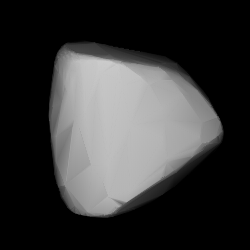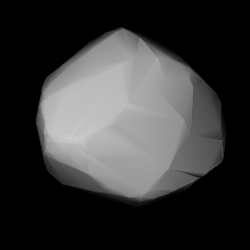
100 Hekate is a large main-belt asteroid.

103 Hera is a moderately large main-belt asteroid with an orbital period of 4.44 years. It was discovered by Canadian-American astronomer James Craig Watson on September 7, 1868, and named after Hera, queen and fifth in power of the Olympian gods in Greek mythology. This is a stony S-type asteroid with a silicate surface composition.
106 Dione is a large main-belt asteroid. It probably has a composition similar to 1 Ceres. It was discovered by J. C. Watson on October 10, 1868, and named after Dione, a Titaness in Greek mythology who was sometimes said to have been the mother of Aphrodite, the Greek goddess of love and beauty. It is listed as a member of the Hecuba group of asteroids that orbit near the 2:1 mean-motion resonance with Jupiter. The orbital period for this object is 5.66 years and it has an eccentricity of 0.17.
123 Brunhild is a stony S-type main-belt asteroid. It was discovered by German-American astronomer C. H. F. Peters on July 31, 1872, and named after Brünnehilde, a Valkyrie in Norse mythology. Brunhild has been mistaken for the non-existent variable star KN Gem.

184 Dejopeja is a large M-type Main belt asteroid. It was discovered by Johann Palisa on February 28, 1878, and was named after Deiopea, a Roman nymph.

214 Aschera is a Main belt asteroid. It was discovered by Austrian astronomer Johann Palisa on February 29, 1880, in Pola and was named after the Sidonian goddess Asherah.

233 Asterope is a large main-belt asteroid that was discovered on 11 May 1883, by French astronomer Alphonse Borrelly at Marseille Observatory in Marseille, France. The asteroid was named after Asterope, one of the Pleiades.

283 Emma is a large asteroid of the asteroid belt and the namesake of the Emma family. It was discovered by Auguste Charlois on 8 February 1889, in Nice, France. The reason for its name is unknown.

318 Magdalena is a main belt asteroid orbiting the Sun. It was discovered by Auguste Charlois on 24 September 1891 in Nice. It may be named for Mary Magdalene, who in legend travelled to Southern Gaul and is the patron saint of Provence.

395 Delia is a large Main belt asteroid. It was discovered by the French astronomer Auguste Charlois on 30 November 1894 in Nice. "Delia" is an epithet for the ancient Greco-Roman Moon goddess Artemis, for her birthplace at Delos. This asteroid is orbiting the Sun at a distance of 2.79 AU with an orbital eccentricity (ovalness) of 0.085 and a period of 4.64 yr. The orbital plane is tilted at an angle of 3.35° to the plane of the ecliptic.
415 Palatia is a large main belt asteroid that was discovered by German astronomer Max Wolf on 7 February 1896 in Heidelberg.

556 Phyllis is a minor planet orbiting the Sun. It is an S-type asteroid with a diameter of 38 km and a geometric albedo of 0.185. Based on photometric observations between 1998 and 2006, it has a synodic rotation period of 4.293 ± 0.001 hours. The asteroid is named after Phyllis, a character in Greek mythology.
823 Sisigambis is an asteroid belonging to the Flora family in the Main Belt. Its diameter is about 17 km and it has an albedo of 0.179. Its rotation period is unknown but appears to be greater than at least 12 hours. The asteroid is named after Sisygambis, the mother of Darius III of Persia.
935 Clivia belongs to the Flora family of Main Belt asteroids. Its diameter is about 7.9 km and it has an albedo of 0.197 .
2007 McCuskey, provisional designation 1963 SQ, is a carbonaceous asteroid from the inner regions of the asteroid belt, approximately 22 kilometers in diameter. It was discovered on 22 September 1963, by astronomers of the Indiana Asteroid Program at Goethe Link Observatory near Brooklyn, Indiana, United States. The asteroid was later named after American astronomer Sidney McCuskey.

77185 Cherryh (provisional designation 2001 FE9) is a background asteroid from the central regions of the asteroid belt, approximately 4 kilometers (2.5 miles) in diameter. It was discovered on 20 March 2001, by American amateur astronomers Don Wells and Alex Cruz at the George Observatory in Needville, Texas. The dark asteroid was named for American writer C. J. Cherryh.
118401 LINEAR (provisional designation 1999 RE70, comet designation 176P/LINEAR) is an active asteroid and main-belt comet that was discovered by the Lincoln Near-Earth Asteroid Research (LINEAR) 1-metre telescopes in Socorro, New Mexico on September 7, 1999. (118401) LINEAR was discovered to be cometary on November 26, 2005, by Henry H. Hsieh and David C. Jewitt as part of the Hawaii Trails project using the Gemini North 8-m telescope on Mauna Kea and was confirmed by the University of Hawaii's 2.2-m (88-in) telescope on December 24–27, 2005, and Gemini on December 29, 2005. Observations using the Spitzer Space Telescope have resulted in an estimate of 4.0±0.4 km for the diameter of (118401) LINEAR.
(35671) 1998 SN165 (provisional designation 1998 SN165) is a trans-Neptunian object from the Kuiper belt located in the outermost region of the Solar System. It was discovered on 23 September 1998, by American astronomer Arianna Gleason at the Kitt Peak National Observatory near Tucson, Arizona. The cold classical Kuiper belt object is a dwarf planet candidate, as it measures approximately 400 kilometers (250 miles) in diameter. It has a grey-blue color (BB) and a rotation period of 8.8 hours. As of 2021, it has not been named.
24626 Astrowizard (provisional designation 1980 TS3) is a dark background asteroid from the central regions of the asteroid belt, approximately 7 kilometers in diameter. It was discovered on 9 October 1980, by American astronomer couple Carolyn and Eugene Shoemaker at the Palomar Observatory in California, United States. The asteroid was named for American science educator David Rodrigues, who would perform at public events as "The Astro Wizard".
(444030) 2004 NT33 is a classical trans-Neptunian object and possible dwarf planet of the Kuiper belt in the outermost region of the Solar System, approximately 450 kilometers in diameter. It was discovered on 13 July 2004, by astronomers at Palomar Observatory, California, United States.










